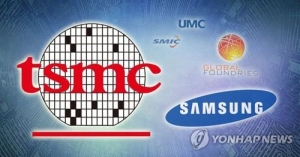Strong performance of Intel, TSMC advances… Samsung Electronics was good, but it wasn’t profitable
Samsung’s operating margin is the lowest among 3 companies… Will it be ranked in the rise of DRAM prices this year?


Last year, among the top three global semiconductor companies, Intel, Samsung Electronics, and TSMC in Taiwan, Samsung Electronics’ semiconductor operating profit fell to the third place.
According to the financial investment industry on the 24th, Samsung Electronics, which disclosed its tentative results on the 8th of this month, is estimated to have a total of 73 trillion won in annual sales and 19 trillion won in operating profit for the semiconductor division last year.
This is an improved performance from 2019 (sales of 64.900 trillion won and operating profit of 14 trillion won).
#1 is Intel. Intel, which released its results on the 21st (U.S. local time), posted annual sales of about 77.8 billion dollars and operating profit of about 23.7 billion dollars last year. Applying the current standard won-dollar exchange rate, the annual sales are 86 trillion won and the operating profit is 26.2 trillion won. This is 13 trillion won in sales and 7 trillion won in operating profit than Samsung Electronics. Last year, Intel recorded all-time high sales.
Intel, whose flagship is the central processing unit (CPU), recorded a record-breaking sales, as the demand for laptops and PCs increased by 33% due to Corona even though sales in the enterprise data center division decreased by 16% compared to the previous year.
The second place is TSMC, a Taiwanese foundry (consigned semiconductor production) company. TSMC, which released the final results on the 14th, recorded sales of Taiwanese dollars (about 52.99 trillion won) last year, and operating profits of Taiwanese dollars (566.5 trillion won) (about 22 trillion won).
Sales are 20 trillion won or more lower than Samsung Electronics’ semiconductors, but operating profit is about 3 trillion won.
Last year, thanks to the strong performance of Intel and TSMC, Samsung Electronics was pushed to the second place in sales and third in operating profit among global semiconductor companies.
In 2017-2018, during the memory semiconductor super boom, Samsung ranked first in both sales and operating profit, but except then, most of the sales and operating profits remained second only to Intel.
However, with the rapid growth of the global foundry market from 2019, TSMC, which has advanced technology and capital, is striking up.
TSMC produced similar operating profits to Samsung Electronics (14 trillion won), which had been somewhat sluggish after the super boom in 2019, and widened the gap by surpassing Samsung Electronics’ profits last year.
Even considering that Samsung Electronics’ earnings were somewhat unfavorable due to the strong won-dollar exchange rate in the fourth quarter of last year, TSMC made more profits.
TSMC, which runs only foundries, posted an operating margin of 42.3% last year. In the second half of last year, despite the loss of a large customer named Huawei of China due to US sanctions, it made more than 40% of operating profit due to the shortage of foundry supply. In 2017-2019, the company’s operating margin was 37.2-39.4%.
By comparison, the operating margin of Samsung Electronics’ semiconductor division last year is estimated to be around 26% on average. This is lower than that of Intel (30.4%).
Samsung Electronics, an integrated semiconductor company (IDM), has a wide operating margin gap by sector, not only memory semiconductors such as DRAM and NAND flash, but also system semiconductors and foundries such as mobile application processors (AP).
Securities estimates that Samsung Electronics’ DRAM operating margin is high at 40%, but NAND is at around 20% and non-memory division is at around 10%.
In the system semiconductor and foundry sectors, where Samsung Electronics is missing the top spot in the global market, it is not making as much profit as memory semiconductors.
An official in the semiconductor industry said, “Samsung Electronics is a general semiconductor company, but it is a weak point that the profit fluctuations according to the semiconductor business cycle are large as Samsung Electronics is highly dependent on the memory sector, which has relatively large price fluctuations.” It is necessary to disperse the risk by strengthening it.”
/ Reporter Cho Hyuk-shin [email protected]
Copyright holder © Incheon Ilbo Unauthorized reproduction and redistribution prohibited
